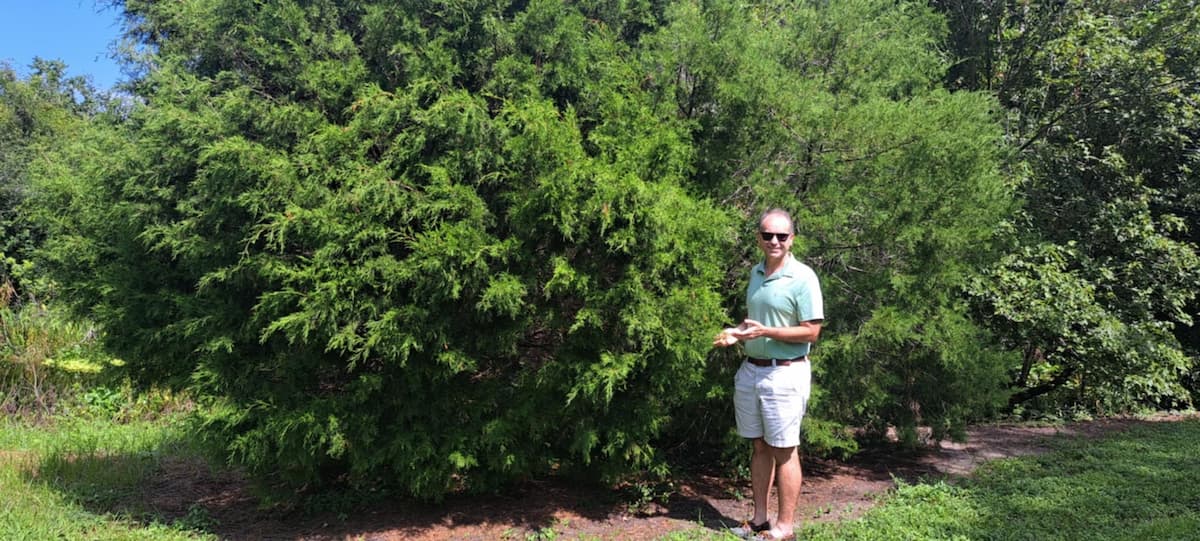Growing eastern red cedar trees is something I just love to do…
They’re a type of juniper tree native to vast swaths of eastern North America from Florida west to the Plains and north into southeastern Canada.
There are many names for eastern red cedar (Juniperus virginiana), including red juniper, eastern juniper, Virginian juniper, and red cedar.
Whatever you call them, if you can grow them in your yard, you’ll probably love them, too.
Butterflies and other pollinators certainly do… They’re attracted to the little cones that resemble berries. This makes the tree great for butterfly gardens. Birds love eastern red cedars, too. It’s not just about the cones. These dense, conical evergreen trees provide shelter for cover and nesting. Sparrows, robins, warblers, and other birds take harbor in eastern red cedars during the winter.
I have an eastern red cedar growing as a specimen that anchors the landscape near the side of my home in the front yard. It’s serving as something of an understory tree within the shade line of a tall oak, and both trees seem to coexist quite well — they have for years now.
My eastern red cedar has been nothing but a joy. It’s low maintenance, doesn’t need much pruning, and is generally a no-fuss, no-muss tree.
But how do you go about growing eastern red cedar trees? Let me share some tips from my experience having successfully grown one.
How To Grow Eastern Red Cedar Trees
#1: Aim for full sun to partial shade
Eastern red cedars grow well in full sun to partial shade conditions, though as they grow larger, they tend toward preferring full sun. In my case, I’m growing my eastern red cedar tree in a spot where it saw mostly partial shade during its first years given its location adjacent to and partly under the canopy of an oak. Yet, as it gets taller, exceeding the height of a 6-foot fence nearby and my 1-story house, the top of the eastern red cedar is seeing full sun on a southern exposure. This mix of full sun and partial shade will likely behoove the tree in the long run.
#2: Be careful exposing your eastern red cedar to temperature extremes
The native range of the eastern red cedar in the United States keeps it out of major temperature extremes. It doesn’t really grow well in southern Florida, where extreme heat rules most of the calendar. Nor does it grow in the chilly hinterlands of northern Canada. And it doesn’t creep into the Rockies, where high altitudes ensure year-round cool climes. If you know your yard is prone to dramatic temperature swings, an eastern red cedar may not be suited to grow there. The location where my eastern red cedar is growing protects it from the blazing sun during the summer, helps keep it free of frost and exposure to freezes in the winter, and keeps it happy throughout each growing season.
#3: Choose a location far enough from your home and other structures for growing eastern red cedar trees
Eastern red cedar is a tree — a typical specimen may grow 40 feet to 50 feet tall and perhaps 10 feet to 20 feet wide. Some grow much bigger than that, reaching heights of 90 feet and widths beyond 25 to 30 feet. Keep this in mind when growing eastern red cedar trees in your yard. Oh, and eastern red cedars are known to live beyond 500 years. So, once it gets growing, it’s not likely to stop anytime soon! When I planted my eastern red cedar I kept it a good 8 feet to 10 feet from the house — I fully expect both my eastern red cedar and my home to still be here in, say, 300 to 500 years. And I plan on being here to make sure of it! Somehow…
#4: Give your eastern red cedar plenty of irrigation early on, but…
…Don’t overdo the water, especially as the tree gets older. You see, eastern red cedars are likely to get stressed in drought conditions, and they certainly need plenty of water to help them establish their roots. But they also don’t like standing water. Thankfully they’re adaptable to a variety of soil conditions. They don’t even mind salty, seaside locations. But what they may have in versatility, they lack in tolerance for standing water. So, make sure their soil has decent drainage, and don’t plant them in a swamp!
#5: Don’t over prune eastern red cedars
Some plants don’t mind heavy pruning. But eastern red cedar isn’t one of these plants. In fact, over pruning eastern red cedars can do some serious damage. And chopping back its main leader? Well, that’s liable to stunt the tree’s growth altogether — it may never recover from such a rash pruning decision. Never remove more than half of the eastern red cedar’s foliage (green growth). And frankly you’re best to avoid removing more than a quarter to a third. I remove only dead branches or the occasional edge or two that gets in the way of my lawn mower when I’m cutting the grass. If there’s one plant you want to think twice about before pruning, it’s the eastern red cedar!
